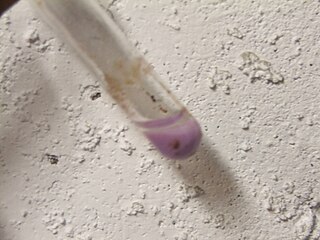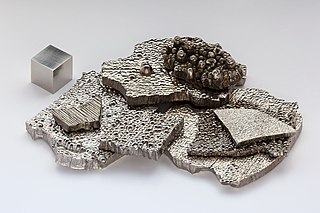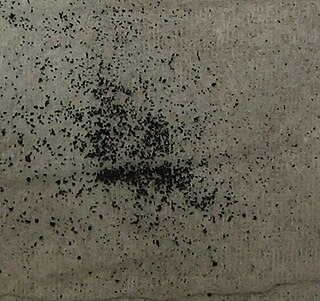
Iron(III) oxide or ferric oxide is the inorganic compound with the formula Fe2O3. It is one of the three main oxides of iron, the other two being iron(II) oxide (FeO), which is rare; and iron(II,III) oxide (Fe3O4), which also occurs naturally as the mineral magnetite. As the mineral known as hematite, Fe2O3 is the main source of iron for the steel industry. Fe2O3 is readily attacked by acids. Iron(III) oxide is often called rust, and to some extent this label is useful, because rust shares several properties and has a similar composition. To a chemist, rust is considered an ill-defined material, described as hydrated ferric oxide.

Cobalt(II) chloride is an inorganic compound of cobalt and chlorine, with the formula CoCl
2. It is a sky blue crystalline solid.

Cobalt(III) fluoride is the inorganic compound with the formula CoF
3. Hydrates are also known. The anhydrous compound is a hygroscopic brown solid. It is used to synthesize organofluorine compounds.

Cobalt(II) fluoride is a chemical compound with the formula (CoF2). It is a pink crystalline solid compound which is antiferromagnetic at low temperatures (TN=37.7 K) The formula is given for both the red tetragonal crystal, (CoF2), and the tetrahydrate red orthogonal crystal, (CoF2·4H2O). CoF2 is used in oxygen-sensitive fields, namely metal production. In low concentrations, it has public health uses. CoF2 is sparingly soluble in water. The compound can be dissolved in warm mineral acid, and will decompose in boiling water. Yet the hydrate is water-soluble, especially the di-hydrate CoF2·2H2 O and tri-hydrate CoF2·3H2O forms of the compound. The hydrate will also decompose with heat.
Cobalt green is an ambiguous term for either of two families of green inorganic pigments. Both are obtained by doping cobalt(II) oxide into colorless host oxides.

Cobalt Nitrate is the Inorganic compound with the formula Co(NO3)2.xH2O. It is cobalt(II) salt. The most common form is the hexahydrate Co(NO3)2·6H2O, which is a red-brown deliquescent salt that is soluble in water and other polar solvents.

Lithium cobalt oxide, sometimes called lithium cobaltate or lithium cobaltite, is a chemical compound with formula LiCoO
2. The cobalt atoms are formally in the +3 oxidation state, hence the IUPAC name lithium cobalt(III) oxide.

Cobalt(II) sulfate is any of the inorganic compounds with the formula CoSO4(H2O)x. Usually cobalt sulfate refers to the hydrate CoSO4.7H2O, which is one of the most commonly available salts of cobalt.

Cobalt(II) bromide (CoBr2) is an inorganic compound. In its anhydrous form, it is a green solid that is soluble in water, used primarily as a catalyst in some processes.

Cobalt(II) hydroxide or cobaltous hydroxide is the inorganic compound with the formula Co(OH)
2, consisting of divalent cobalt cations Co2+
and hydroxide anions HO−
. The pure compound, often called the "beta form" is a pink solid insoluble in water.
Stock nomenclature for inorganic compounds is a widely used system of chemical nomenclature developed by the German chemist Alfred Stock and first published in 1919. In the "Stock system", the oxidation states of some or all of the elements in a compound are indicated in parentheses by Roman numerals.
Percobaltates are chemical compounds where the oxidation state of cobalt is +5. This is the highest established oxidation state of cobalt. The simplest of these are bi-metallic Group 1 oxides such as sodium percobaltate (Na3CoO4); which may be produced by the reaction of cobalt(II,III) oxide and sodium oxide, using oxygen as the oxidant:

Bromopentaamminecobalt(III) bromide is the dibromide salt of the cobalt coordination compound with the formula [Co(NH3)5Br]2+ It is a purple, water-soluble solid. The analogous Chloropentaamminecobalt(III) chloride is also well known.
Cobalt(III) nitrate is an inorganic compound with the chemical formula Co(NO3)3.
In materials and electric battery research, cobalt oxide nanoparticles usually refers to particles of cobalt(II,III) oxide Co
3O
4 of nanometer size, with various shapes and crystal structures.
Cobalt(III) hydroxide or cobaltic hydroxide is a chemical compound with formula Co(OH)
3 or H
3CoO
3. It is an ionic compound, with trivalent cobalt cations Co3+
and hydroxyl anions OH−
.
This page is based on this
Wikipedia article Text is available under the
CC BY-SA 4.0 license; additional terms may apply.
Images, videos and audio are available under their respective licenses.














